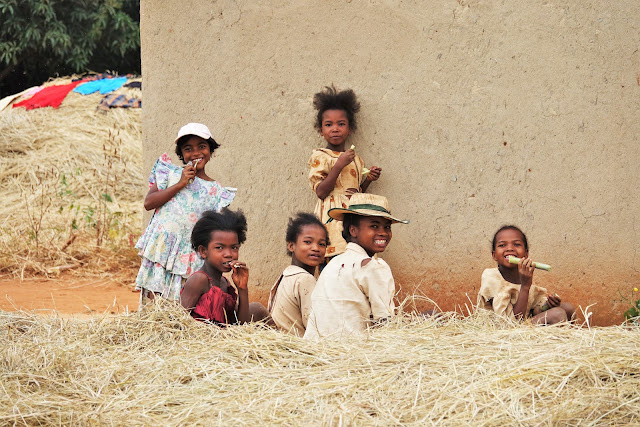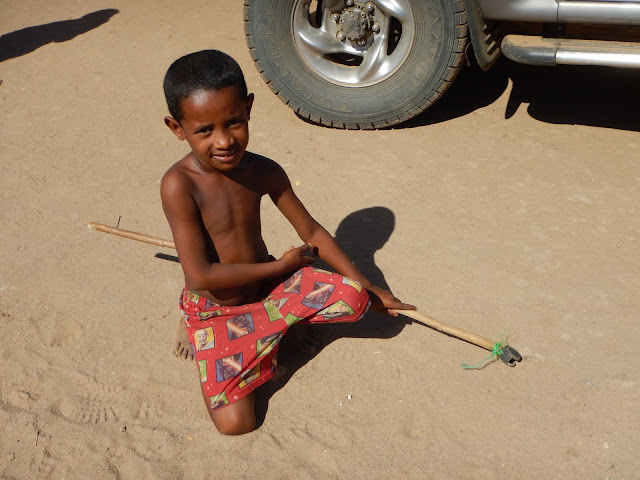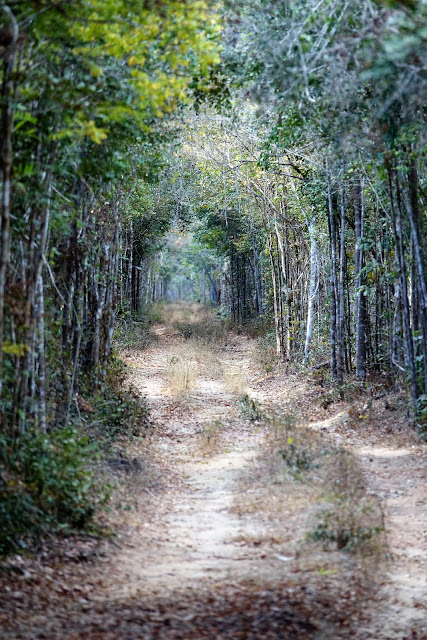Madagascar - The Road Trip that Took us Back in Time (June 3-10)
As we flew into "the red island" we could see that it was largely undeveloped and quite green though the earth beneath was definitely red.
 |
| A view of the spine of Madagascar from the plane |
 |
| A lot of stampin', stickin', and signin' to get into the country! (one of them is the exit stamp, the rest for entry) |
Next, we found a taxi brousse to take us into the city. Taxi brousses are Madagascar's answer to public transit, they are basically minibuses that run on established routes carrying locals around the city. We asked around a bit and found one that wasn't too full, then climbed aboard through the rear door with our luggage while the "manager" hung off the back and tried to encourage more people to hop in.
 |
| riding in the taxi brousse, still plenty of room for people in the aisles, the manager hangs on at the back, collects money, and lets people on and off |
The taxi brousse took us into the centre of Antananarivo ("Tana") and when we got out on the side of the road we were surrounded by the bustle of the city - cream colored, very old taxis lined up on one side of the street, people and animals everywhere, people selling their wares all around (including kids selling cigarettes), everyone staring as we loaded on our backpacks and figured out our next move.
Communication was a bit tough because the locals speak Malagasy, and a bit of French... using the little French we know, we relied on the assistance of another passenger from the Seychelles and our booking confirmation on our phone to arrange a ride to our guesthouse with one of the taxi drivers.
With all of our gear we barely fit into the taxi, a car of about 1950s vintage, and in very poor condition. As we pulled away from the curb, exhaust fumes filled our lungs as doubt filled our heads - would this car even make it up the hill to our guesthouse? The driver reached around and locked all of our doors as we drove, apparently protecting us from bandits on the way to our guesthouse. The drive to the guesthouse wasn't far, but traffic was at a standstill most of the way, almost every vehicle spewing black exhaust fumes, it was super gross and we thought it couldn't get much worse when BOOM! we were rear-ended by a big work truck and sent lurching forward about a foot. The noise of the impact was so loud, and we were jostled pretty hard - poor Maya was terrified until she understood what had happened and that it was actually ok. The drivers sorted out the details of the accident and then we slowly carried on up the hill to our guesthouse, the car stalling every now and then and the driver revving it like crazy to get it started again, fumes spewing but unable to open windows for fear of bandits... Madagascar made a pretty rough first impression on us!
 |
| One of the taxis of 'Tana' - they are all this color and vintage, but come in different shapes and sizes |
We finally got to our guesthouse, run by a lovely couple who spoke quite a bit of English and gave us a very comfortable place to stay and to recover from the ordeal of getting to their house! They were shocked that we took a taxi brousse, claiming that they were "too dangerous", and said that we should have called them for a ride. (In fact, the taxi brousse are perfectly safe and are used widely by backpackers) - our guesthouse owners were from a fairly elite section of the population of Madagascar - they were well educated, owned a huge house and 2 vehicles, and employed at least 3 Malagasy people - a maid/cook, a general helper, and a driver. It was interesting to see how they live compared to the average Malagasy person, since Madagascar is the 6th poorest nation in the world.
We talked with the guesthouse owners, Richard and Fara, at length about what we hoped to see in our 2 weeks on Madagascar, and eventually agreed that the simplest and safest thing to do was to hire their 4x4 car and driver to take us first to the southwest to see the Tsingy, then back to Tana, then to the east to see the lemur. There are no trains or buses on Madagascar, and internal flights are expensive and unreliable (Air Madagascar is nicknamed "Air Maybe" because it often doesn't fly when it is scheduled to). We could have taken a taxi brousse but they are notoriously late, run out of fuel, are overcrowded, not to mention apparently unsafe, so hiring a private driver made the most sense for us.
June 3-10:
The first day with the driver, Jean-Pierre, we drove around Tana visiting a Madagascar Chocolate factory (mmm) and going to a mall (of sorts) to get some snacks/supplies for the trip which would start the next day. Jean-Pierre was a great driver in the city and we were up bright and early the next morning to head out on the highway toward Morondava, which was about 650 km away. Richard advised that it was a 2 day trip because the highway isn't in good condition and, because of bandits, it is dangerous to drive after dark. Oh boy! was this threat real? or was it the "well-to-do" mentality, where the "haves" fear the "have nots".
Jean Pierre's highway driving was quite different from his city driving. On the highway he seemed fearful, lurching and braking hard all the time. He couldn't seem to distinguish a shadow from a pothole (and there were many), so he would brake hard and swerve around both. At first it was kind of amusing but as we developed nausea from all of the lurching we became pretty annoyed by it. We weren't sure if he had poor eyesight, but he did have glasses... He also honked around almost every corner, just in case someone was coming. It was a little trying, but like so many things, we can look back on it now and have a laugh...No surprise the brake pads needed replacing when we got back, it was that bad!
So, we drove for 2 days and saw life along the highway of the 6th poorest country in the world.... here is a list that we composed as we drove:
Antananarivo to Morondava
Things Seen on the Drive that We Wouldn't See at Home:
A lady coming to our car to sell her homemade cheese at a gas station
-we didn't get a photo of this but we did buy some of her cheese, it was decent!
Men, women, and children using mother natures toilet along the roadside
- again, no photo, but people were squatting here, there, everywhere
Slash and burn agriculture
-burning everything to make space to grow crops like corn, we could feel the heat from the fires as we drove by
-burning everything to make space to grow crops like corn, we could feel the heat from the fires as we drove by
A group of about 100 men, all carrying weapons of some sort (scythes, shovels, spears etc) walking along the road heading from one village to the next. Our driver tensed up, sped up as we were passing them, firmly pushed my camera down and said "No" when I went to take a photo, and gave a huge sigh of relief when we were past them. Because of the language barrier we couldn't understand what the situation was but he later told Richard and Fara that they were bandits going to steal from another village. We're still not sure....but something was definitely going on!
People sitting along the edge of the road which made a good bench as the "ashphalt" was raised slightly from the red dirt on each side of the road, spots in the shade seemed to attract groups of locals.
 |
| sitting by the road watching things go by |
 |
| people resting on the roadside in the shade before they tackle the hill |
Stands where food, drinks, cigarettes are sold, usually run by a woman with her kids along the roadside
 |
| a group of gals selling beer and misc items |
Babies in every group of people - most families seemed to have one
| young girls holding babies - often they were strapped in but not this time |
 |
| a young mother walking barefoot through town with her strapped in baby |
People bathing in the muddy rivers
 |
| scrub a dub |
Cows (zebu) with humps of fat on their necks
 |
| zebu are used for work and for meat |
Taxi Brousse stuffed full of people, with supplies piled high in top
 |
| not a typical taxi brousse but same idea, full inside and on top |
Little kids running around without adults in the middle of town or out along the highway
 |
| kids enjoying some sugar cane beside the highway |
 |
| out for a stroll - middle of nowhere |
A basket of live ducks on the roof of a Taxi Brousse:
 |
| a bicycle, a cooler, a basket of ducks...nothing unusual here! |
People carrying things on their heads- baskets, coolers, loads of straw, brooms, etc
 |
| carrying wood for a cooking fire |
 |
| the best way to carry a sewing machine |
 |
| baskets of something going somewhere... their clothes tell a story too |
 |
| women carrying dishes to the river to wash... check out the condition of the road too |
 |
| starting at an early age |
Black exhaust fumes from 80% of the vehicles
 |
| a pretty typical amount of exhaust fumes - left us sputtering a lot |
Carts loaded with all sorts of things being pulled, pushed or ridden by boys/men
 |
| pushing a load through the streets of 'Tana' - How to get by if you don't have a car! |
 |
| this seems a tad bit easier |
Large poinsettia bushes growing along the side of the road
 |
| a young girl and a poinsettia bush |
Laundry washed in muddy rivers or ponds then set out to dry on the ground, on rocks and in bushes
 |
| doing laundry in the river |
 |
| laundry in the channel created by an aid organization near a village |
 |
| even in 'Tana' - the capital city, those who live without running water wash their laundry in the river |
People walking in bare feet everywhere
 |
| a group of beautiful barefoot girls... the red soil colors their clothes...they are curious about us and very friendly! |
People walking several kilometers to/from the river to bathe, wash laundry, do dishes, etc
 |
a typical scene near the river, women walking with babies on backs,
laundry on heads, more people on their way there or back in the distance
|
Rice drying on the side of the road, sometimes in a tarp, sometimes directly on the road, sometimes with chickens or ducks pecking through it...or pigs
 |
| this little piggie eats rice on the road |
 |
| no tarps under this rice.. wonder how much is lost? |
Guys playing foosball at tables set up on the roadside
 |
| foosball between the rice fields and the highway |
Young girls (mostly) with their faces masked by a yellow/orange wood extract used as protection from the sun's rays
 |
| a young chicken seller protecting her face from the sun |
Red earth everywhere, red dust everywhere ...
 |
| dust this color gets on everything |
 |
| even the money got filthy and tinted red - a new bill from bank machine and an old one from a store |
Ferry loaded with cars and trucks being pulled across the river by hand using a fixed rope
 |
| Man-power moves this ferry |
Dozens of small villages along the side of the road, brick, grass, or wood huts with grass roofs sometimes with boards or metal pieces. Sometimes there might be a village well installed by an aid organization, but often there was no running water at all and no electricity.
 |
| the streetfront view of a village |
 |
| the housing section of a village |
Kids using ordinary items as toys
 |
| a wheel on a stick is a good toy |
 |
so is a plastic jug on a rope
|
Locals staring and sometimes waving as we went by in our car or walked in the street
 |
| beautiful girls |
 |
| friendly lil' locals |
 |
| Lucas handing an empty water bottle to a boy running beside our car |
 |
| Chris giving a water bottle to a little one |
 |
| Lucas with a little buddy he just gave a water bottle to |
 |
Maya gave this little gal a bottle - she had white clothes, shoes, and a bag - she was likely a little better off than most
|
 |
Our kids giving some treats to some Malagasy kids from the backseat of our car - after seeing how these kids
lived we wished we had brought all kinds of clothes, shoes, toothbrushes, etc.
|
The long drives were fascinating because there were small villages so often, and so much to see as we drove through the villages. Between villages the views were often very nice with rolling hills and small settlements dotting the landscape.
 |
| a nice view with a village built of brick/clay |
 |
| What 3rd world country? This is so comfortable! But something doesn't feel right... |
Richard and Farah's place was also very comfortable, but we did stay in some less fancy, but perfectly adequate places while in the parks. The one below was actually a really well run camp, very clean, proving that every bungalow isn't a dungalow!
 |
| Our little bungalows, girls in one, boys in the other |
 |
| A light, a fan, a bed with a mosquito net - what more do you really need? I mean, this is way more than the locals have. |





Comments
Post a Comment